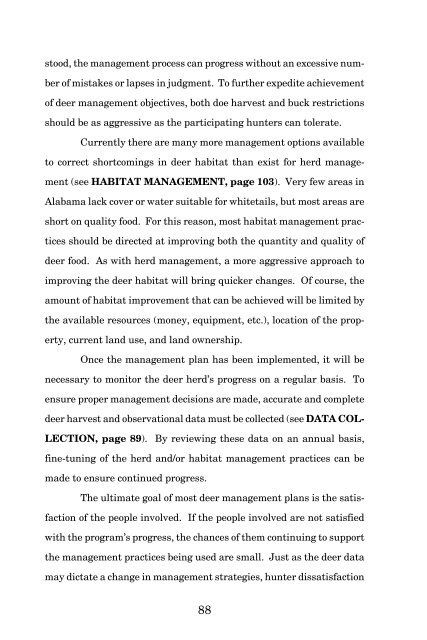Biology And Management Of White-tailed Deer In Alabama
Biology And Management Of White-tailed Deer In Alabama
Biology And Management Of White-tailed Deer In Alabama
Create successful ePaper yourself
Turn your PDF publications into a flip-book with our unique Google optimized e-Paper software.
stood, the management process can progress without an excessive number<br />
of mistakes or lapses in judgment. To further expedite achievement<br />
of deer management objectives, both doe harvest and buck restrictions<br />
should be as aggressive as the participating hunters can tolerate.<br />
Currently there are many more management options available<br />
to correct shortcomings in deer habitat than exist for herd management<br />
(see HABITAT MANAGEMENT, page 103). Very few areas in<br />
<strong>Alabama</strong> lack cover or water suitable for whitetails, but most areas are<br />
short on quality food. For this reason, most habitat management practices<br />
should be directed at improving both the quantity and quality of<br />
deer food. As with herd management, a more aggressive approach to<br />
improving the deer habitat will bring quicker changes. <strong>Of</strong> course, the<br />
amount of habitat improvement that can be achieved will be limited by<br />
the available resources (money, equipment, etc.), location of the property,<br />
current land use, and land ownership.<br />
Once the management plan has been implemented, it will be<br />
necessary to monitor the deer herd’s progress on a regular basis. To<br />
ensure proper management decisions are made, accurate and complete<br />
deer harvest and observational data must be collected (see DATA COL-<br />
LECTION, page 89). By reviewing these data on an annual basis,<br />
fine-tuning of the herd and/or habitat management practices can be<br />
made to ensure continued progress.<br />
The ultimate goal of most deer management plans is the satisfaction<br />
of the people involved. If the people involved are not satisfied<br />
with the program’s progress, the chances of them continuing to support<br />
the management practices being used are small. Just as the deer data<br />
may dictate a change in management strategies, hunter dissatisfaction<br />
88
















